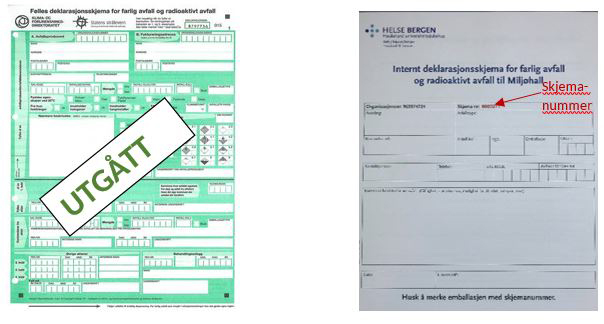Management of hazardous waste in HUS areas

Copyright: Colorbox
Employees working in areas owned by Helse-Bergen should follow hospital guidelines for waste disposal.
In the common waste disposal rooms there are cardboard boxes, inserts, red plastic bags, wires and labels. The cardboard boxes should, as a safety measure, be labelled with the appropriate label prior to use. When they are ¾ full they should be closed and placed in the waste room for collection.
Locations:
Common waste disposal room: every floor.
Hazardous waste disposal room: ask the contact person for each floor.
The contact person can be contacted if you need more information.
HUS instructions for waste
Applies to the laboratory building, the Glassblocks and KK
Instructions for HUS waste management HAZARDOUS WASTE: HUS Håndtering av farlig avfall 2022
Instructions for HUS waste management HAZARDOUS WASTE: HUS farlig avfall plakat
Instructions for Handling and labeling of waste and special waste: Håndtering av avfall og spesialavfall
Poster for sorting waste HUS Sorting guide: HUS Sorteringsveileder
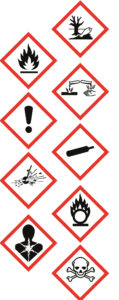 Waste management requirements:
Waste management requirements:
- Disposal of chemicals and packaging without hazardous labelling, are treated as standard waste.
- Other hazardous waste must be handled and packaged in accordance with law and regulation.
- Empty chemical bottles, solvents containing cytostatics and methanol plastic containers must be declared
- The waste must be packed safely so that transport damage does not occur. Eg. Use shock absorbing material between glass bottles.
- Declaration form must be filled out for each item.
Hazardous waste:
EE waste: Wastes from electrical and electronic products contain both valuable resources and components with hazardous properties. Examples: Mercury switches, PCB-containing capacitors and circuit boards with brominated flame retardants.
Radioactive waste: Radiation sources used to treat diseases, radiation sources in instruments and analysis tools. Equipment that has been contaminated by radioactive radiation or radioactive substances.
Packaging:
1: Biological waste:
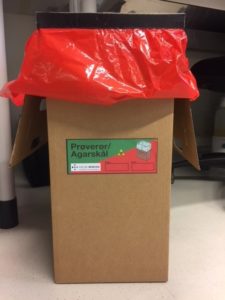 Cardboard box: For laboratory work and daily use. These boxes are sorted in 3 categories and placed in the waste rooms. Use red or yellow plastic bags according to instructions.
Cardboard box: For laboratory work and daily use. These boxes are sorted in 3 categories and placed in the waste rooms. Use red or yellow plastic bags according to instructions.
Cytostatic: Here smaller amounts of cytostatics, antibiotics and materials which may be cancerous, mutagens, poisonous, health damaging or damaging to the environment should be discarded. The boxes are frozen to -20°C in the Environmental hall and then transported for combustion at 900-1000°C.
Test tubes/agar plates: Contagious waste such as used agar plates and test tubes which contain blood or tissue fluids. As well disposable equipment and gloves which may be contaminated or have been in contact with organic test material, and 10 litre liquid container from cell lab (containing Virkon). The boxes are frozen to -20°C in the Environmental hall and then transported for combustion at 900-1000°C.
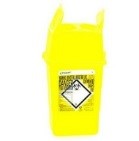
Sharps: Yellow plastic boxes with lids for hypodermic needles, scalpel blades, microscope slides and other glass/sharp objects. These yellow plastic boxes should be purchased by each group. Please note that there can not be liquid exceeding 500ml (max liquid volume for the autoclave). The boxes are then transported for combustion at 450-500°C.
2 Chemical waste:
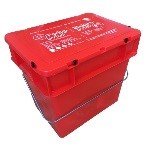 Red waste box: Dangerous waste should be packaged in its original packaging or some other suitable packaging and labelled with the declaration number.
Red waste box: Dangerous waste should be packaged in its original packaging or some other suitable packaging and labelled with the declaration number.
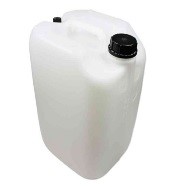 Clear plastic container: Solvent without halogen, not in its original packaging, should be put in the clear container and labelled with the declaration number.
Clear plastic container: Solvent without halogen, not in its original packaging, should be put in the clear container and labelled with the declaration number.
 Blue plastic container: Solvent with halogen, not in its original packaging, should be put in the blue container and labelled with the declaration number.
Blue plastic container: Solvent with halogen, not in its original packaging, should be put in the blue container and labelled with the declaration number.
3 Low radioactive waste:
Discarded objects, biological materials, solutions or substances that contain or have been contaminated with radioactive substances should be collected and thrown in a cardboard box containing a red bag and labelled as radioactive waste.

Sticker for radiation waste
Use the sticker to fill in:
- Content: i.e. Cell lines in 96-well tray
- Activity: 3 H Tritsium
- Content of isotopes: Tritsium – 3H
- Activity appr.: <0.2 μS
- Department: NN
- Date: xx.xx.xx
- Responsible: NN
Handle empty, hazardous chemical bottles:
